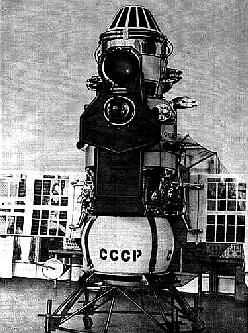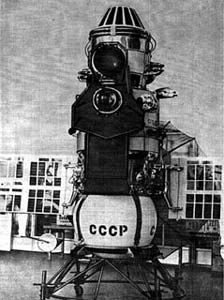
Home - Search - Browse - Alphabetic Index: 0- 1- 2- 3- 4- 5- 6- 7- 8- 9
A- B- C- D- E- F- G- H- I- J- K- L- M- N- O- P- Q- R- S- T- U- V- W- X- Y- Z
Venera 2V (V-69)
Part of 2MV Family

Venera 5
Credit: NASA |
Russian Venus probe. Spacecraft was very similar to Venera 4 / 1V (V-67) although the descent module was of a stronger design. Venus lander, Russia. Launched 1969.
AKA: 2V;2V (V-69). Status: Operational 1969. First Launch: 1969-01-05. Last Launch: 1969-01-10. Number: 2 . Gross mass: 1,128 kg (2,486 lb).
When the atmosphere of Venus was approached, a capsule weighing 405 kg and containing scientific instruments was jettisoned from the main spacecraft. During descent towards the surface of Venus, a parachute opened to slow the rate of descent. For 53 min on May 16, 1969, while the capsule was suspended from the parachute, data from the Venusian atmosphere were returned. The spacecraft also carried a medallion bearing the coat of arms of the U.S.S.R. and a bas-relief of V.I. Lenin to the night side of Venus.
More at: Venera 2V (V-69).
Family: Venus.
Country: Russia.
Engines: KDU-414.
Launch Vehicles: R-7,
Molniya 8K78M.
Projects: Venera.
Launch Sites: Baikonur,
Baikonur LC1.
Agency: MOM,
Lavochkin bureau.
Bibliography: 2,
296,
367,
376,
474,
6,
64,
13330.
Photo Gallery
 | Venera 4
Credit: Manufacturer Image |
1969 January 5 - .
06:28 GMT - .
Launch Site: Baikonur.
Launch Complex: Baikonur LC1.
Launch Pad: LC1 or LC31. LV Family: R-7.
Launch Vehicle: Molniya 8K78M.
- Venera 5 - .
Payload: 2V (V-69) s/n 330. Mass: 1,128 kg (2,486 lb). Nation: Russia.
Related Persons: Babakin.
Agency: MOM.
Program: Venera.
Class: Venus.
Type: Venus probe. Spacecraft Bus: 2MV.
Spacecraft: Venera 2V (V-69).
Decay Date: 1969-05-16 . USAF Sat Cat: 3642 . COSPAR: 1969-001A.
Venera 5 is launched at 9:26 Moscow time from LC-31 in -23 deg C temperatures. All proceeds according to plan. Afterwards Kamanin meets Babakin. Venera 6 is planned for launch in 10 January. He also plans two moon landings in 1969 and two in 1970 of soil sample return spacecraft. Kamanin does not believe America can achieve a manned moon landing in 1969, and therefore that Babakin has a very good chance of stealing their thunder. Meanwhile Venera 5 was launched from its parking orbit towards Venus to obtain atmospheric data. The spacecraft was very similar to Venera 4 although it was of a stronger design. When the atmosphere of Venus was approached, a capsule weighing 405 kg and containing scientific instruments was jettisoned from the main spacecraft. During satellite descent towards the surface of Venus, a parachute opened to slow the rate of descent. For 53 min on May 16, 1969, while the capsule was suspended from the parachute, data from the Venusian atmosphere were returned. The spacecraft also carried a medallion bearing the coat of arms of the U.S.S.R. and a bas-relief of V.I. Lenin to the night side of Venus.
1969 January 8 - .
- Plan for Soviet lunar and planetary launches to answer America's Apollo program during 1969 approved. - .
Nation: Russia.
Related Persons: Babakin.
Spacecraft: Luna Ye-8,
Luna Ye-8-5,
Mars M-69,
Soyuz 7K-L1,
Venera 2V (V-69).
Central Committee of the Communist Party and Council of Soviet Ministers Decree 19-10 'On Work on Research of the Moon, Venus and Mars by Automatic Stations--work on automated lunar and interplanetary spacecraft' was issued..
Additional Details: here....
1969 January 10 - .
05:51 GMT - .
Launch Site: Baikonur.
Launch Complex: Baikonur LC1.
Launch Pad: LC1 or LC31. LV Family: R-7.
Launch Vehicle: Molniya 8K78M.
- Venera 6 - .
Payload: 2V (V-69) s/n 331. Mass: 1,128 kg (2,486 lb). Nation: Russia.
Agency: MOM.
Program: Venera.
Class: Venus.
Type: Venus probe. Spacecraft Bus: 2MV.
Spacecraft: Venera 2V (V-69).
Decay Date: 1969-05-17 . USAF Sat Cat: 3648 . COSPAR: 1969-002A.
Venera 6 was launched towards Venus to obtain atmospheric data. When the atmosphere of Venus was approached, a capsule weighing 405 kg was jettisoned from the main spacecraft. This capsule contained scientific instruments. During descent towards the surface of Venus, a parachute opened to slow the rate of descent. For 51 min on May 17, 1969, while the capsule was suspended from the parachute, data from the Venusian atmosphere were returned. The spacecraft also carried a medallion bearing the coat of arms of the U.S.S.R. and a bas-relief of V.I. Lenin to the night side of Venus.
1969 May 16 - .
- Venera 5 lands on Venus - .
Nation: Russia.
Related Persons: Keldysh.
Spacecraft Bus: 2MV.
Spacecraft: Venera 2V (V-69).
Keldysh first revealed the new 'party line' at a press conference on the mission. When asked about Soviet lunar plans, he revealed that Russia would only use robot probes, that it wouldn't risk men's lives in such an endeavour..
1969 May 16 - .
1969 May 17 - .
1969 May 17 - .
- Venera 6 lands on Venus - .
Nation: Russia.
Flight: Apollo 10.
Spacecraft Bus: 2MV.
Spacecraft: Venera 2V (V-69).
Kamanin notes in his diary that the twin Venus missions mark a new triumph of the USSR in space, but pale in comparison with the American launch of Apollo 10. Kamanin notes there is not one word about the Apollo 10 mission in Pravda..
Home - Search - Browse - Alphabetic Index: 0- 1- 2- 3- 4- 5- 6- 7- 8- 9
A- B- C- D- E- F- G- H- I- J- K- L- M- N- O- P- Q- R- S- T- U- V- W- X- Y- Z
© 1997-2017 Mark Wade - Contact
© / Conditions for Use
|


